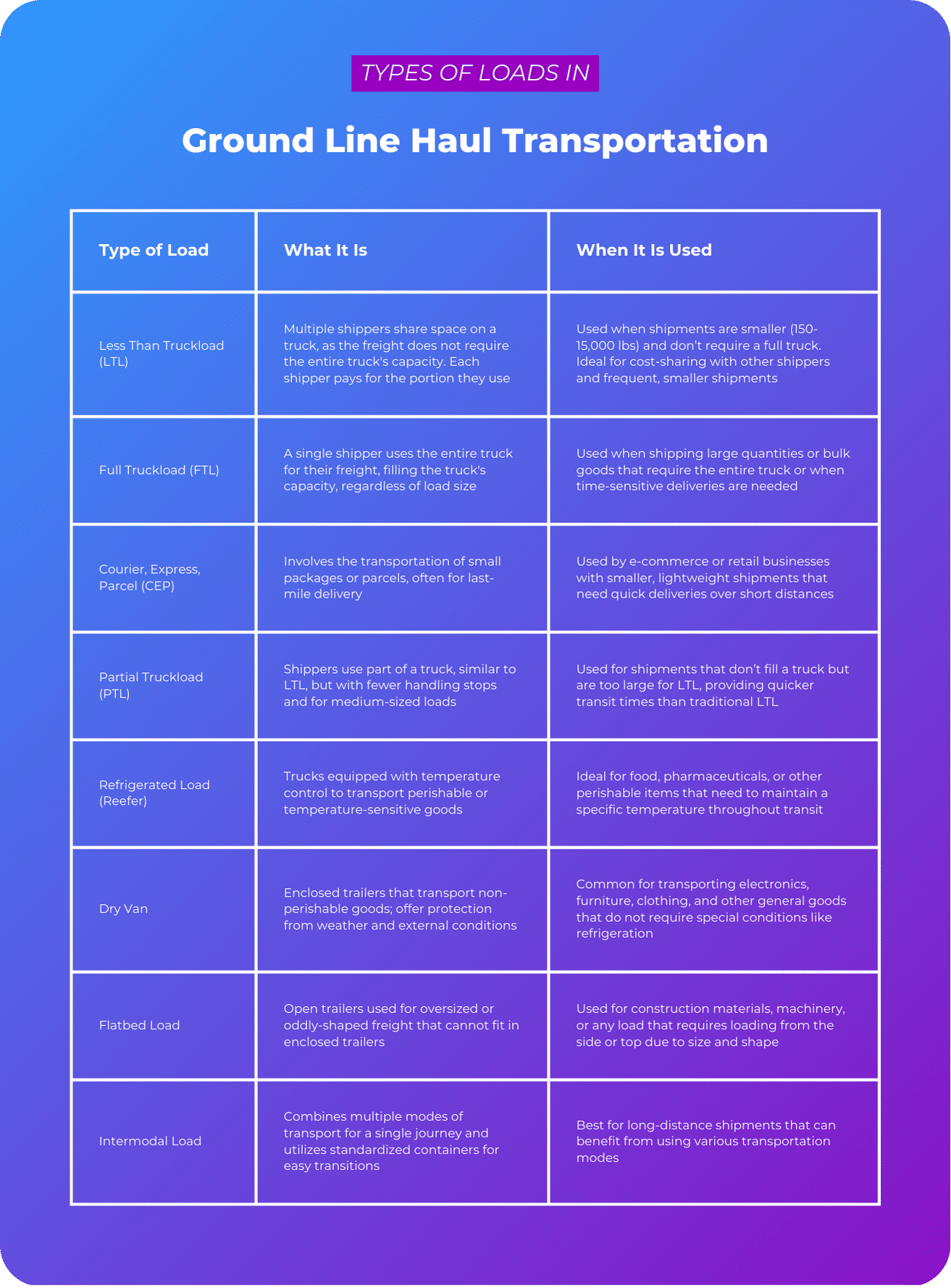What Is Line Haul Transportation and Why Should You Track It?

Ground line haul tracking provides real-time visibility into your shipments, enables faster delivery, lowers costs, and improves customer satisfaction.
Ground line haul refers to the long-distance transportation of goods using trucks or trains. It handles a range of freight, from small packages to heavy pallets, and is commonly used by courier, express, and parcel (CEP) providers, less-than-truckload (LTL) carriers, and third-party logistics firms.
Step-by-Step Process of Ground Line Haul Transportation
- Freight Pickup: Logistics providers collect goods from depots, warehouses, or designated collection hubs.
- Initial Consolidation: The collected shipments are transported to a central depot, where they are grouped with other goods headed for the same destination or region.
- Loading for Transport: After consolidation, the freight is loaded onto trucks, trailers, or containers for long-distance transport. The mode of transport (e.g., road or rail ) is chosen based on the distance, size, and urgency of the shipment.
- Ground line Haul Transport: The freight is moved across long distances, usually between cities or major hubs, in this core phase of the journey. Depending on the shipment’s requirements, multiple transportation modes may be involved to optimize speed and cost.
- Arrival at Distribution Hub: Once the freight reaches the distribution hub, it is unloaded at a sorting facility for further processing. This facility acts as a midpoint before the goods are dispatched to their final destination.
- Sorting and Re-Consolidation: At the hub, the shipments are sorted and consolidated again, this time for local or regional deliveries based on final destinations.
- Dispatch for Last-Mile Delivery: After sorting, the goods are loaded onto smaller vehicles for final delivery to customers. This last-mile transport covers the shortest part of the journey: delivery to homes, offices, or businesses.
- Last-Mile Delivery: The consolidated freight is dispatched from the distribution center for last-mile delivery. These smaller vehicles or trucks deliver the goods to their final destinations, whether they are businesses, retail locations, or residential addresses.
- Post-Delivery Analysis: Logistics providers analyze delivery performance using data collected during the journey. This helps streamline future operations, optimize routes, and ensure cost-effective solutions for upcoming shipments.
Ground line haul transport is faster and more cost-effective than long haul transportation, which involves moving goods over extremely long distances, sometimes between countries or continents. Also, long haul shipments require more resources and are subject to higher costs due to the extended travel time and infrastructure involved, whereas line haul focuses on shorter, more manageable routes. This allows for more frequent trips, predictable schedules, and advanced tracking, all of which contribute to its cost-efficiency and speed.
Moreover, by consolidating goods with similar destinations and optimizing routes, ground line haul transportation reduces delays and lowers overall shipping expenses, and is therefore, a preferred choice for companies that want to maintain a reliable and timely supply chain. Simply put, it supports global commerce by providing an efficient way to transport goods over long distances, but at a faster pace and reduced cost compared to traditional long haul logistics.
Other Modes of Line Haul Transport
Ground line haul is an industry standard primarily because of its convenience and cost-effectiveness. But there are other ways of line haul transport too.
Air Line Haul Transportation
Air line haul involves cargo planes and is used for both international and intercontinental shipments. This mode is the fastest and is well-suited for high-value or urgent deliveries. However, it is generally the most costly option for shipping.
Sea Line Haul Transportation
Sea line haul uses cargo ships to transport goods across oceans. It is a cost-effective option for bulk shipments that are not time-sensitive. Although slower than air transport, it can handle much larger volumes of cargo.

What is Ground Line Haul Tracking?
Ground line haul tracking is the process of monitoring shipments during the long-distance part of their transportation. It involves the use of technology to provide real-time updates on the shipment’s location and status as it moves through the line haul phase of logistics.
Here are five key aspects of ground line haul tracking:
- Real-Time Tracking: This feature allows continuous monitoring of the shipment’s exact location during the long-haul journey. GPS and telematics enable both the line haul carrier and the customer to know where the goods are at any given moment.
- Route Optimization: The system tracks not just location but also the progress of the shipment along the planned route. It may also suggest alternative routes in case of traffic, road closures, or weather disruptions to ensure timely delivery.
- Estimated Time of Arrival (ETA): Line haul tracking systems also provide information on the shipment’s estimated time of arrival. That way, stakeholders are always in the know as to when they should expect their goods at the next hub or final destination.
- Event and Milestone Alerts: As shipments pass through key points, like checkpoints or distribution hubs, etc., the system records these events and notifies the shipper or customer of the progress. Delays or issues along the way are also flagged in real time.
- Visibility for Customers: Many ground line haul carriers provide customers with access to a tracking portal, so they can follow the journey of their shipment throughout the line haul process. This transparency ensures better planning and coordination on the receiving end.
10 Key Benefits of Ground Line Haul Tracking to Your Logistics Business
Improved SLA Management
Real-time tracking provides visibility into the status of shipments, which enables logistics businesses to monitor and manage compliance with Service Level Agreements (SLAs). Performance metrics and reports too, help them assess fleet performance and identify areas for improvement.
Timely Issue Resolution
A good line haul tracking system quickly identifies problems such as vehicle breakdowns or road accidents. They trigger instant notification alerts, seeing which you can dispatch maintenance teams promptly or reroute shipments to prevent delivery delays and ensure smooth operations.
Flexible Rerouting and Scheduling
If you’re a ground line haul carrier, you must often find it hard to redirect routes when traffic or weather conditions change all of a sudden. Fortunately, with a good line haul tracking system, you can use real-time data to adjust routes and schedules in response to unforeseen circumstances. This adaptability helps minimize disruptions and maintain efficient delivery processes.
Regulatory Compliance
Ground line haul tracking ensures that logistics companies adhere to regional regulations and laws, such as speed limits or weight restrictions. This helps you avoid heavy penalties and unnecessary litigation.
Better Customer Experience
End customers can also monitor their shipments’ progress and receive timely updates. This leads to a better overall service experience and, subsequently, higher customer satisfaction.
Optimized Resource Management
Accurate ground line haul tracking data enables you to plan and allocate drivers and vehicles efficiently and judiciously. Effective optimization of resources further reduces operational costs, improves fleet management, and enhances overall efficiency.
Increased Security
With ground line haul tracking, you can also monitor shipments for any unauthorized deviations from journey plans. In case of any suspicions with a certain driver or route, you can tighten security measures and reduce the risk of theft or loss of goods.
Cost Efficiency
Logistics companies can analyze route performance and fuel consumption and make informed decisions to cut costs and increase profitability.
Better Communication
Real-time tracking facilitates better communication between shippers, carriers, and customers. This seamless flow of information ensures that everyone is on the same page at all times.
Data-Driven Insights
Ground line haul tracking provides valuable data and analytics which can be used to assess performance trends, forecast demand, and revamp logistics strategies.
Are You A Ground Line Haul Carrier….
Looking to streamline your middle mile and cross-border logistics? Mile’s multimodal logistics management software provides you with real-time, end-to-end visibility, facilitates shipment and documentation handling at depots, and ensures smoother workflows from start to finish.
Schedule a demo today: https://www.milenow.com/book-demo/
